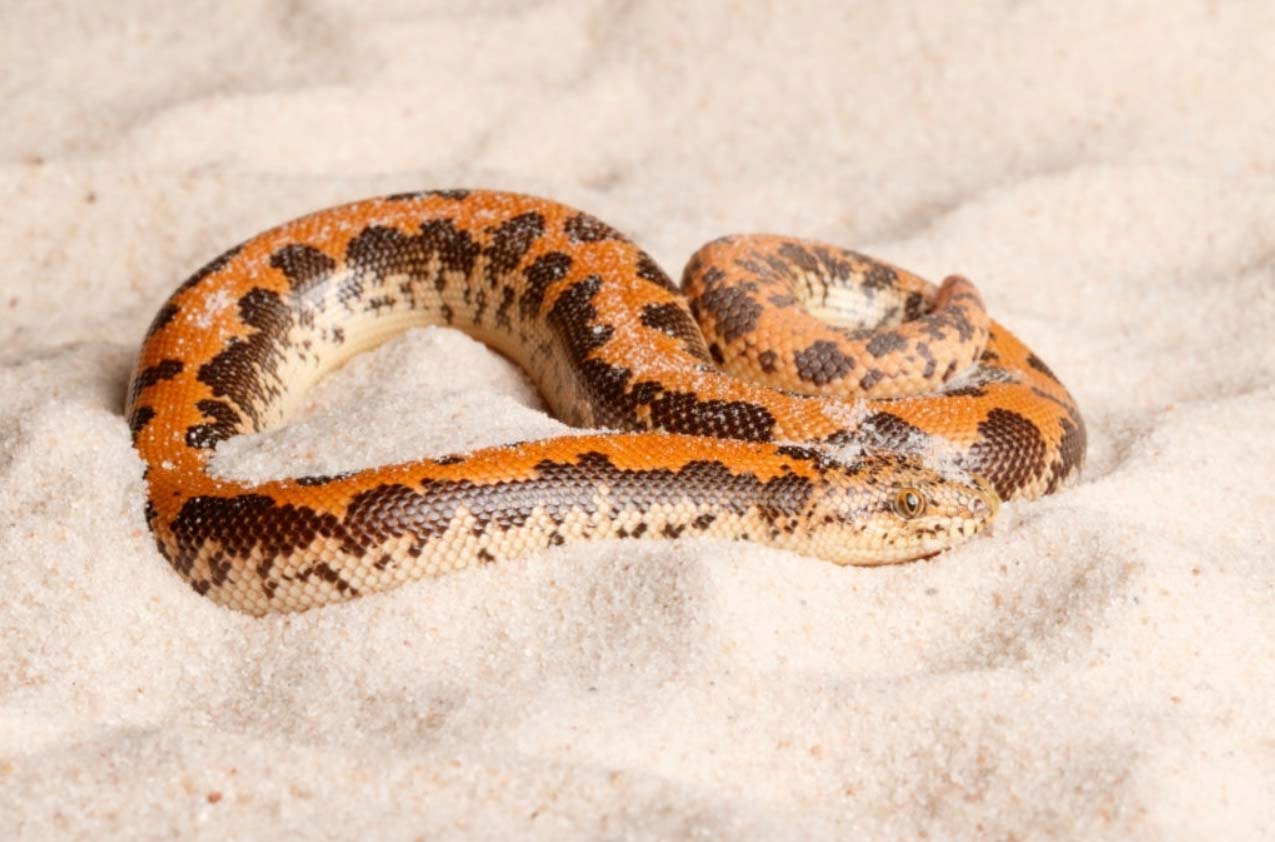Kenyan sand boas (Gongylophis colubrinus) are docile species that have been rapidly growing in popularity.
Their easy care, laidback temperament, and hardiness make them popular for both new and experienced keepers.
Though ball pythons are often cited as the best snake for beginners, the sand boa has all of the same characteristics that make ball pythons desirable.
Beyond this, its size and tank requirements make it an objectively better choice for first-time reptile owners.
This guide covers all the facts you’ll need to know about Kenyan sand boas. We’ll discuss their temperament, care, breeding, and more in-depth.
Reptile Overview
Despite its name, the Kenyan sand boa (aka Eryx colubrinus) isn’t only found in Kenya!
It’s also native to Egypt, Yemen, Libya, Sudan, Niger, Tanzania, Ethiopia, Chad, and Somalia.
Because of its wide geographic origin, this reptile is also sometimes referred to as the East African sand boa.
However, Kenyan sand boa is still its most common name.
Though once rare, captive-bred sand boas are now commercially available both domestically and internationally.
This is a smaller snake that has more straightforward care requirements than many others. It’s easy to keep, very hardy, and not prone to many genetic diseases.
Behavior & Temperament

These snakes are very docile and don’t mind frequent handling. They’re generally well behaved, though some may be skittish.
More active individuals may wiggle or jerk. Over time, they’ll adjust to you and being handled.
Boas also aren’t used to being outside of their burrows. This is another reason why they may move strangely in your hands or on solid ground.
The more you properly handle your boa, the tamer it will become. It’s best to regularly handle them at least a few times each week.
If your boa seems stressed, reduce how often you handle them. Stress is often indicated by a loss of appetite and hostility.
Remember that snakes are intelligent animals and have individual personalities.
Though the species shares general similarities, each boa may have personal preferences, quirks, etc.
Snake Bites and Aggression
Bites, either aggressive or defensive, are extremely rare. But keep in mind, accidental bites may happen during feeding or if a female is gravid.
If your boa bites you, don’t panic. Their bites are not venomous and generally aren’t more painful than a scratch from a cat or dog.
However, it can still be a traumatic experience for you and your snake. So in the future, make sure to avoid the circumstances that led to the accident.
To prevent this scenario, never reach for the first third of your snake’s body. Instead, aim for the middle of its body. Reach underneath it and make sure to provide support.
Snake hooks also work. You can touch your snake before you take it. This will help your snake understand that your hand (or hook) isn’t a tasty mouse.
Lifespan
Like many reptiles, Kenyan sand boas are a long-term commitment. They’ll be with you for well over a decade.
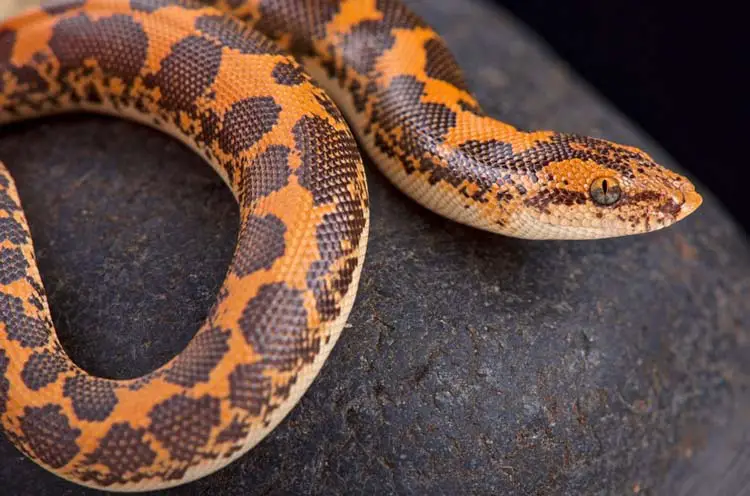
They can live upwards of 20 years or more. There are even reports from owners of their snakes living over 30 years!
If you want a Kenyan sand boa but aren’t prepared for such a long-term commitment, we suggest rescue and adoption. Many adult and senior reptiles need loving homes.
Appearance
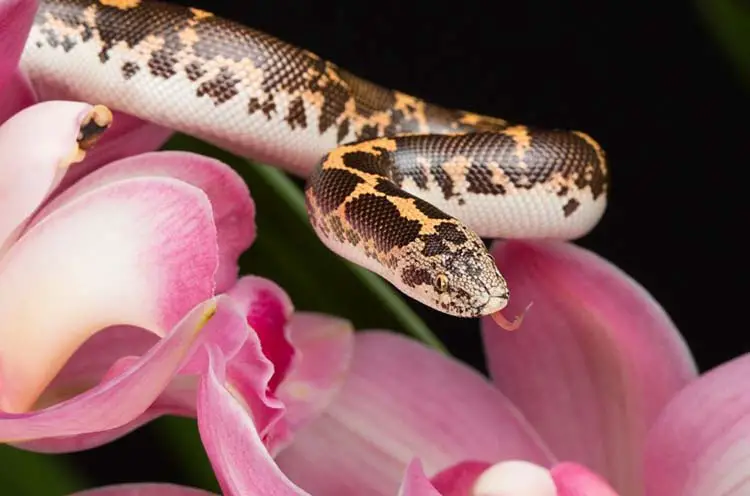
The Kenyan sand boa is a beautiful salmon or yellow color with dark brown or black spots.
However, morphs are also beginning to appear. These are boas with specific color patterns created by selective breeding.
Now, albinos, snows, tigers, and even anerythristic variations are available. But keep in mind, morphs are often more expensive and prone to health issues.
Kenyan sand boas have a stout, thicker body with a rounded nose and head. Though they may seem oddly shaped, their body is the result of amazing environmental adaptations.
Their nose and mouth are shaped this way to avoid ingesting substrate as their burrow. And the end of their tail is covered in keeled scales, which provides traction.

Generally, females are thicker-bodied. This helps support the gestation period and the birthing process.
Female boas can grow anywhere from 24 – 36 inches (2 – 3 feet), give or take a few inches. Males are smaller and only grow up to roughly 24 inches (2 feet).
Captive-bred boas tend to max out around 20 – 24 feet, while snakes sourced from the wild are usually bigger. If possible, always buy or adopt a captive-bred Kenyan sand boa.
Enclosure
This snake needs a 10-gallon enclosure minimum. However, this is more suited to juveniles.
When your boa reaches their adult stage, a 15 or 20-gallon tank is more appropriate. But if you want a bigger tank, your boa certainly won’t complain.
For one adult Kenyan sand boa we recommend 24 x 18 x 12 inches terrarium from Exo Terra.
If you want more than one sand boa, you’ll definitely need to upsize. Plan for at least another 10 gallons per snake.
Because they’re not climbers, horizontal tanks are preferred over vertical ones. The more square footage your tank has, the better.
Many keepers prefer a glass or acrylic tank with a mesh, secure lid. A plastic storage bin in a heated shelving unit will also work.
Since snakes are known for being escape artists, make sure to use cage clips and locks. Also, keep potential escape in mind when adding décor.
Kenyan sand boas aren’t a climbing species, but they are still capable of limited climbing movement. Because of this, they may try to use any tall tank décor as a launchpad.
Females and males may be kept communally, as can females and other females.
However, males should not be housed together.
Substrate and Décor
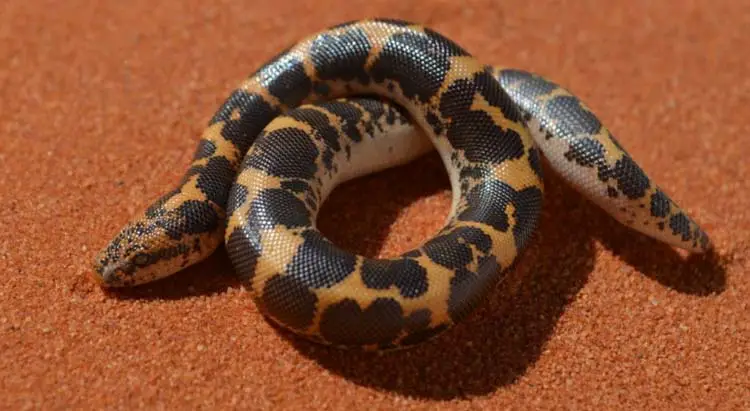
The Kenyan sand boa loves to burrow, so plan for a substrate to be your main feature. They love sand, aspen bedding, coconut mulch, and even newspaper.
We recommend to use natural aspen bedding from Galapagos. It’s great for Kenyan sand boas and any other burying snake. And the most important thing that it’s dust-free!
Galapagos Aspen Digs Shavings Bedding
Stay away from rough materials that could hurt your boa. Gravel, corncob bedding, and cedar shavings are all poor choices.
You’ll need a thick layer of whichever substrate you choose, at least 3 – 4 inches.
Because they’ll spend much of their time below the surface, heavy décor is not recommended. One or two hiding places and a water dish is fine.
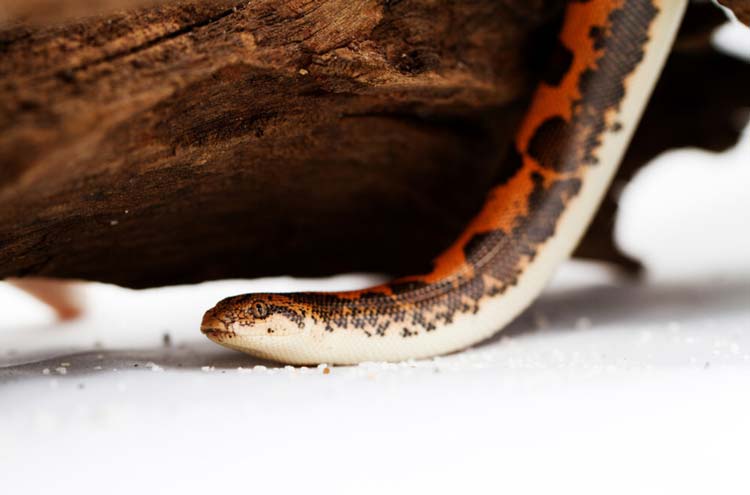
Cork bark and half logs are commonly used. These should be large enough that your boa could curl up inside of them if they so desired. Avoid heavy stones or wood.
Cleaning Requirements
Spot clean your tank on a weekly basis, removing waste and other debris. Deep clean your tank monthly and examine the substrate to see if it needs to be replaced.
Cleaning also involves the equipment, hides, décor, etc. in your tank. It’s more convenient if these are made from easily sanitized materials.
Keep this in mind when you’re purchasing everything for your enclosure. Cork bark may look nicer than a plastic log, but it’s also harder to keep clean.
While you’re cleaning, this is also a great time to check your equipment and make sure it’s in tip-top shape. Properly dispose of damaged equipment and replace it as necessary.
Temperature & Lighting
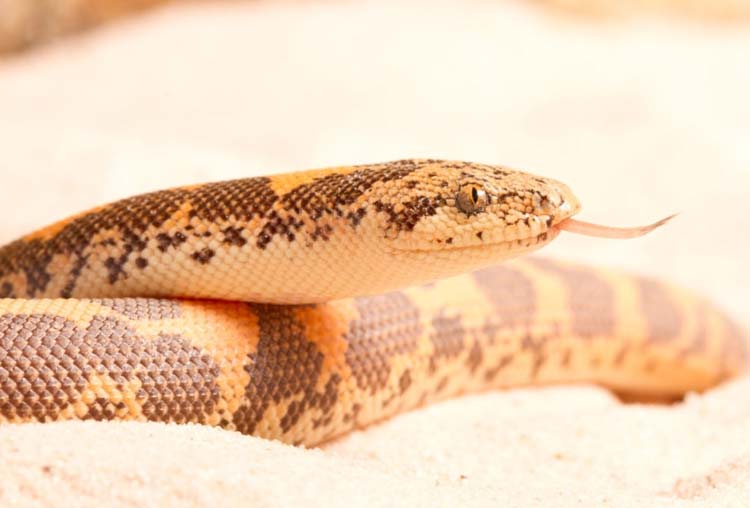
Another benefit to a larger tank is that it’s easier to establish this temperature gradient. Your tank should have a warm side and a comparatively cool side.
The gradient should span roughly 95 – 80°F (35-26°C). At night, it can go down to the 70°F (21°C).
Younger snakes can benefit from warmer temperatures since they’re not as hardy as adults.
This also means that a drop in nighttime temperatures is not entirely necessary.
To make sure the temperature is right, you can use a reptile thermometer.
Some keepers use two thermometers, one on each side of the tank, to make sure the gradient is correct.
Digital laser thermometers let you take temperature readings from anywhere in the tank. These are useful for larger tanks with a heat gradient that may fluctuate more.
You’ll need an undertank (UT) heating pad on one side of the tank. It should take up roughly one-fourth to one-third of the tank bottom.
Our recommendation is VIVOSUN Reptile Heating Pad with digital thermostat. It’s controlled by a thermostat so you can control temperature in enclosure using digital thermostat.
VIVOSUN Reptile Heating Pad with Digital Thermostat
Add an insulating layer or felt reptile carpet, or similar material over the portion of the glass where the heating pad is. This will prevent your snake from burning themselves.
On top of the tank, add an overhead light fixture with a day heat bulb. At night, you can either turn the light off and use a heating mat.
Some owners claim that constant light stresses their sand boa out, while others haven’t witnessed any such side effects.
Either way, if you buy a heating bulb, make sure it’s a purple or blue light since some research suggests red light can damage your boa’s eyesight.
Also, you can choose ceramic heating lamp. It does not emit light and may be one of the heating method. Our recommendation would be Fluker’s Ceramic Heat Emitter.
Basking Lamps And Spots
You can also add a basking lamp and bulb. These differ from heat lamps and bulbs in that they’re usually higher wattage and more directed.
Stones and driftwood are the two most common types of materials used to create a basking spot. There are also commercial basking products like Zoo Med Repti Basking Spot or Fluker’s Basking Spotlight Bulbs.
Zoo Med Repti Basking Spot Lamp
If you add a basking spot, remember to check the temperature.
The basking spot should be at the upper end of the gradient and the warmest spot in the tank, but not hot enough to burn your reptile.
The closer a basking spot is to the bulb, the hotter it will get. For basking spots that involve branches or driftwood, this can quickly become a problem.
Warnings And Recommendations
Conversely, cold temperatures can be just as dangerous. A cooler environment may trigger brumation, which is essentially the reptile version of hibernation.
Brumation is not necessary for captive snakes and can cause otherwise concerning symptoms, such as lethargy and a loss of appetite.
Extremely cold or prolonged cold temperatures can cause illness and death.
All animals benefit from a regular light cycle, and the Kenyan sand boa is no different. Try to keep a regular schedule when it comes to turning the lights on and off.
For owners with unpredictable or busy schedules, light timers, like Zilla Digital Timer, automatically switch lights or turn them on/off at preset times.
Regularly check your enclosure’s heating gradient and lighting. Make sure it’s not too hot (or cold) and that the light isn’t stressing out or hurting your snake.
It’s always a good idea to have backup equipment on hands, such as extra bulbs and heating mats. This way you’re prepared, even if something breaks or your bulb burns out.
If you live in an area where power outages are common, we recommend you look for battery-operated equipment for emergency use.
Humidity
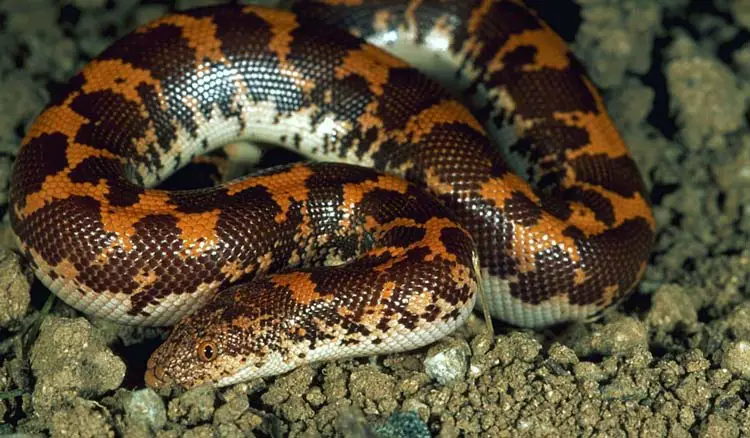
Unlike some other snakes, Kenyan sand boas don’t need high humidity all the time. They like a more arid enclosure that mimics the deserts they originate from.
Humidity around 30% will work most of the time.
The only time they appreciate higher humidity is during their shed cycles. You can increase the humidity throughout the enclosure or provide a temporary shed spot.
Shedding problems are rare but can happen. If your snake can’t shed, increase the humidity and monitor them.
During this period, a humidity of 60 – 65% works better.
You can use a spray bottle or misting system to control humidity. Sphagnum moss is also a great material for holding humidity.
Galápagos Terrarium Sphagnum Moss
Never directly spray your boa, especially with cold water.
A water dish can be provided at all times if your enclosure has a mesh screen top. But in a less ventilated tank, water dishes should only be offered periodically.
A hygrometer measures humidity in the tank. This equipment is just as important as the thermometer.
Zoo Med Labs Digital Hygrometer and Thermometer
It’s normal for humidity to fluctuate, but try to keep these changes to a minimum. Drastic or sudden changes in humidity can cause adverse reactions.
Keep in mind, it’ll be easier to maintain humidity in a bin than a glass or acrylic tank. It can be especially difficult if your tank has a mesh lid.
Always treat your water with a product like ReptiSafe or let it sit for at least 24 hours unsealed. This will get rid of chemicals often found in tap water, such as chlorine.
Diet
Hatchlings and young snakes should be fed pinky mice. As they mature into juveniles and young adults, fuzzies are more appropriate.
When your snake is an adult, then you can begin giving them larger hoppers and adult mice.
Appropriately sized prey should leave a bulge in your boa’s belly but not distend it too much.
Kenyan sand boas prefer live food, specifically mice. Many young snakes will refuse thawed or frozen prey until they’re older.
However, live food has its own drawbacks. The primary concern is that live food fights back and may cause injuries.
To make frozen and thawed food more appetizing, warm it to above room temperature. You can also pierce the prey’s brain to create a more enticing meal.
The best time to feed your boa is when they’re most active. For many snakes, this is in the early evening.
When it comes to thawed or frozen food, you may need to dangle and move it around to simulate live prey. This is especially common with picky eaters and shy individuals.

Boas are constrictors, meaning they’ll strike and then squeeze the mice before eating them.
If your sand boa doesn’t strike, you can lay the food in their enclosure next to a hide. But if they still don’t eat it within a few hours, remove it.
We recommend using long tweezers or tongs to feed your snakes. As mentioned earlier, this prevents accidental bites and prevents your boa from associating your hands with food.
unlumm Feeding Tongs 15″ 2 Pcs
Feeding Schedules and Recommendations
Males usually eat less often than females. But this isn’t always true, so don’t be alarmed if your snake eats every chance he gets.
Since females are larger, they’ll need to be fed more often or in larger quantities.
When shedding, boas may accept food but later discard it. For this reason, you can choose to forgot feeding during their shed cycle.
If you have sand in your enclosure, make sure to feed your snakes on a mat or similar setup to prevent ingestion and impaction.
Some owners prefer to feed their Kenyan sand boas in a completely different enclosure. If you do this, don’t handle your boa 24 hours prior to and after feeding.
A separate enclosure may be necessary if you have more than one boa in your tank. Food often causes aggression, even among mated or friendly pairs.
If your snake later regurgitates its food, this is usually a sign of stress. Remove the food if it’s safe to do so and try to pinpoint the stressor.
Potential Health Issues
As mentioned earlier, morphs are more prone to health issues. Fertility, eyesight, and coordination are the three most common areas affected.
Wobble is one of the worst health issue snakes can be afflicted by. Also known as corkscrewing, this is a neurological condition that affects coordination and is most common in spider morphs.
Kenyan sand boas are specifically at risk of inclusion body disease (IBD), which is a virus transmitted through body fluids.
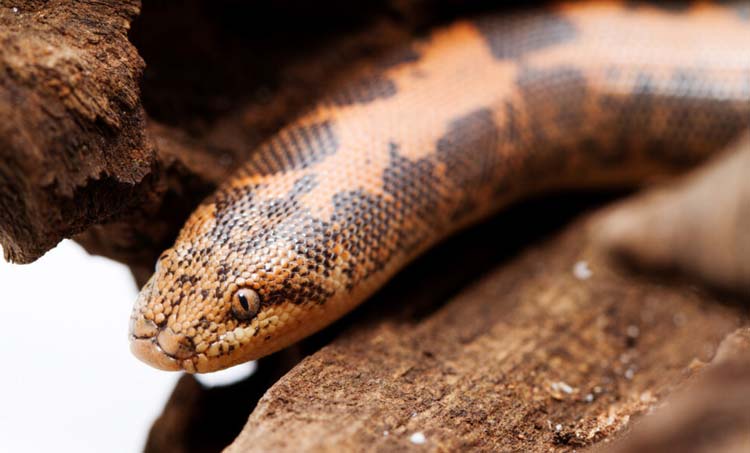
Dirty tanks can cause issues like blister disease, mouth rot, respiratory infections, and fungal infections.
Kenyan sand boas can also hurt their noses trying to escape. If your snake is prone to this, examine them periodically for skin that’s been scraped or rubbed raw.
Injuries can also happen during feedings, especially if you use live prey. It’s not uncommon for boas to suffer from cut tongue sheaths and lacerations around their mouth and eyes.
In general, it’s good practice to arrange annual checkups. But if you see any concerning symptoms or are worried about a specific illness, schedule a visit with your veterinarian as soon as possible.
Since these types of reptiles spend most of their time underneath the substrate, it can be harder to spot when they’re hurt. So when you handle them, make sure to check for injuries.
Breeding
Kenyan sand boas breed easily in captivity. They can be bred at any point during the year as long as specific steps are taken.
Females should be at least two years old, 20 inches, and 325 grams to breed.
Males can breed even before they hit the one-year mark.
When it comes to breeding, larger is always better. Never breed your female if she’s too young or small.
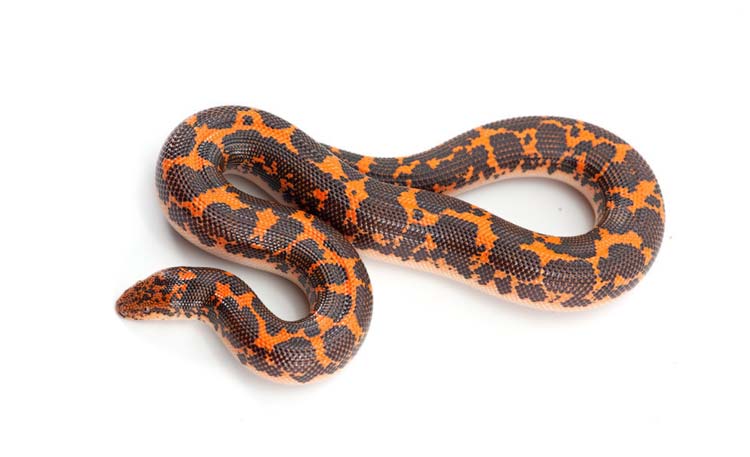
To prepare your female, you’ll need to trigger brumation. This is done by dropping the temperature to the mid-70s of Fahrenheit.
You can drop the temperature suddenly or over a two-week transition period. Both methods have produced successful results.
Prior to lowering the temperature, refrain from offering food for at least two weeks in advance. Do not feed them at all during brumation.
Always make sure fresh water is available.
After two months, begin bringing your female out of brumation. This can also be done suddenly or over a period of time.
Post-Brumation And Courting
Once a week has passed since returning to normal temperatures, begin feeding your sand boa again. Start with small mice twice weekly and work back up to her previous feeding schedule.
Two or three weeks after this point, introduce your male to your female. Usually, courtship will begin immediately or within a few hours.
Monitor them for the next four days, but otherwise, leave them alone. After this, give them both a break for the rest of the week.
Repeat this process two or three more times or until you’re relatively confident the female is pregnant.
If the pair loses interest in breeding and refuses to engage in courtship, separate them.
If one male is not showing interest, even at the start, you can introduce a second male to simulate competition.
However, be prepared for the males to fight and make sure to separate them after a few minutes.
It’s also possible for the breeding process to take place naturally, without any human intervention. If you keep males and females together, they may produce a litter on their own.
Pregnancy And Birth
The gestation period for sand boas is 4 – 6 months. Females often seek out heat during this period, so make sure ample basking spaces and heat sources are available.
One of the Kenyan boa’s amazing and unique traits is that they give birth to live young, not eggs! Females can produce as many as 20 young per litter.
The babies will come out in individual membranes. The mother will consume any unfertilized ova post-delivery.
Once born, the babies should be separated from the mother. They should be provided with the same amenities but in a smaller container or tank.
Hatchlings typically have their first shed a week after birth. Once this happens, you can begin feeding them pinkies.
Conclusion
The Kenyan sand boa is an excellent choice for both new and veteran reptile keepers. This snake is easy to care for, hardy, and beautiful.
Its long lifespan means that you’ll have years (even decades) of joy. And since it’s prone to very few diseases, your snake will live its fullest and longest life with proper care.
Related:

